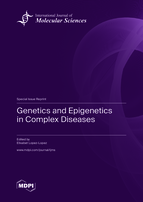Genetics and Epigenetics in Complex Diseases
A special issue of International Journal of Molecular Sciences (ISSN 1422-0067). This special issue belongs to the section "Molecular Genetics and Genomics".
Deadline for manuscript submissions: closed (30 April 2022) | Viewed by 33823
Special Issue Editor
Special Issue Information
Dear colleague,
Many of the most common diseases, such as diabetes, cancer, Alzheimer's disease, or heart disease, are influenced by a combination of multiple factors, which include environmental effectors, as well as genetic and epigenetic factors. Therefore, these diseases are grouped under the term “complex” diseases, because, from the point of view of genetics, they cannot be explained by simple Mendelian inheritance.
Identifying genetic and epigenetic factors involved in such diseases, has proven to be a promising field of research, not only to improve the knowledge of risk factors for those diseases, which could be of help for prevention, but also to improve the understanding and characterization of each disease, and to optimize and personalize the treatment.
Dr. Elixabet Lopez-Lopez
Guest Editor
Manuscript Submission Information
Manuscripts should be submitted online at www.mdpi.com by registering and logging in to this website. Once you are registered, click here to go to the submission form. Manuscripts can be submitted until the deadline. All submissions that pass pre-check are peer-reviewed. Accepted papers will be published continuously in the journal (as soon as accepted) and will be listed together on the special issue website. Research articles, review articles as well as short communications are invited. For planned papers, a title and short abstract (about 100 words) can be sent to the Editorial Office for announcement on this website.
Submitted manuscripts should not have been published previously, nor be under consideration for publication elsewhere (except conference proceedings papers). All manuscripts are thoroughly refereed through a single-blind peer-review process. A guide for authors and other relevant information for submission of manuscripts is available on the Instructions for Authors page. International Journal of Molecular Sciences is an international peer-reviewed open access semimonthly journal published by MDPI.
Please visit the Instructions for Authors page before submitting a manuscript. There is an Article Processing Charge (APC) for publication in this open access journal. For details about the APC please see here. Submitted papers should be well formatted and use good English. Authors may use MDPI's English editing service prior to publication or during author revisions.
Keywords
- genetics
- epigenetics
- complex diseases
- biomarkers
- susceptibility
- prognosis
- characterization
- treatment personalization







